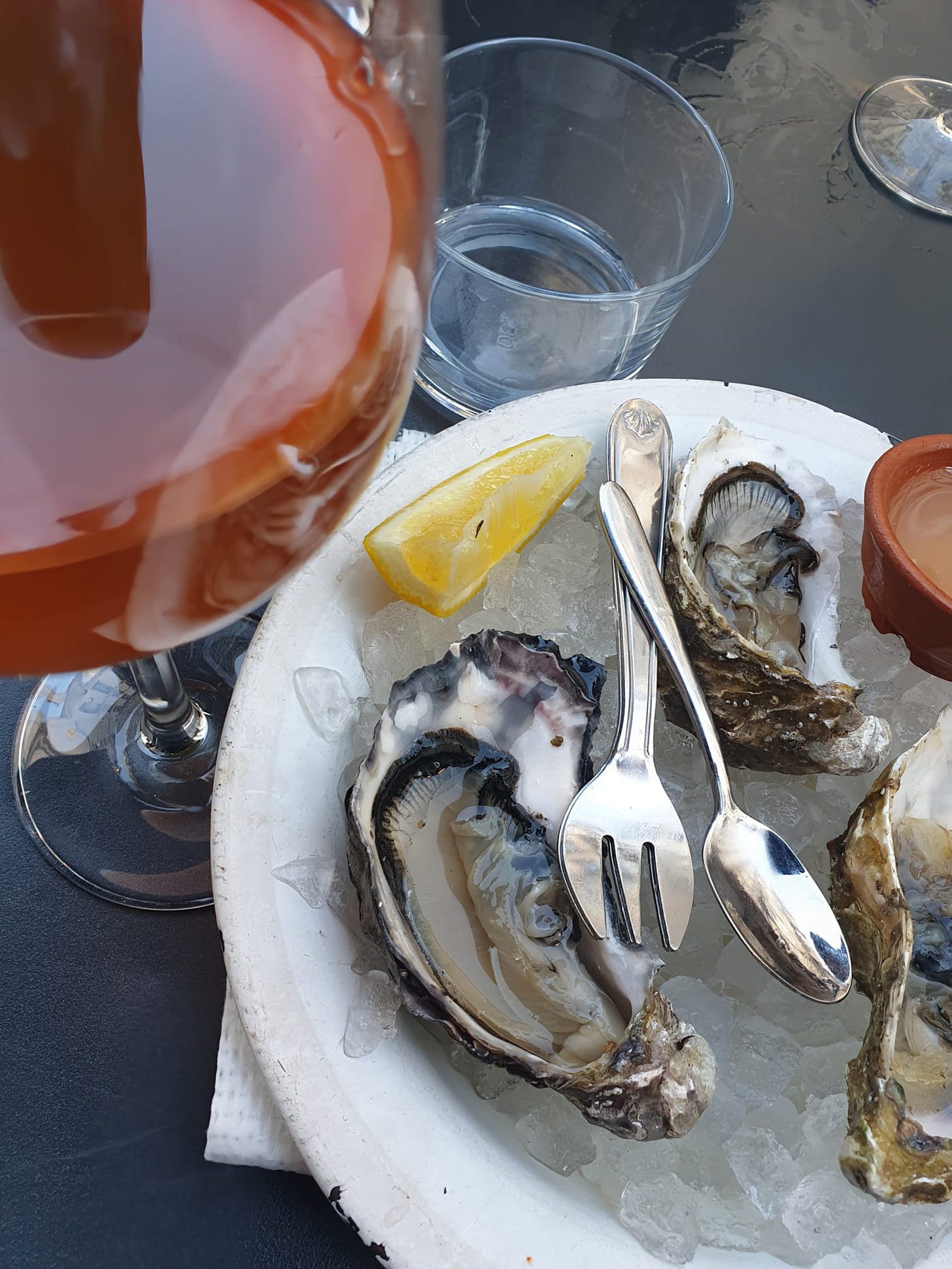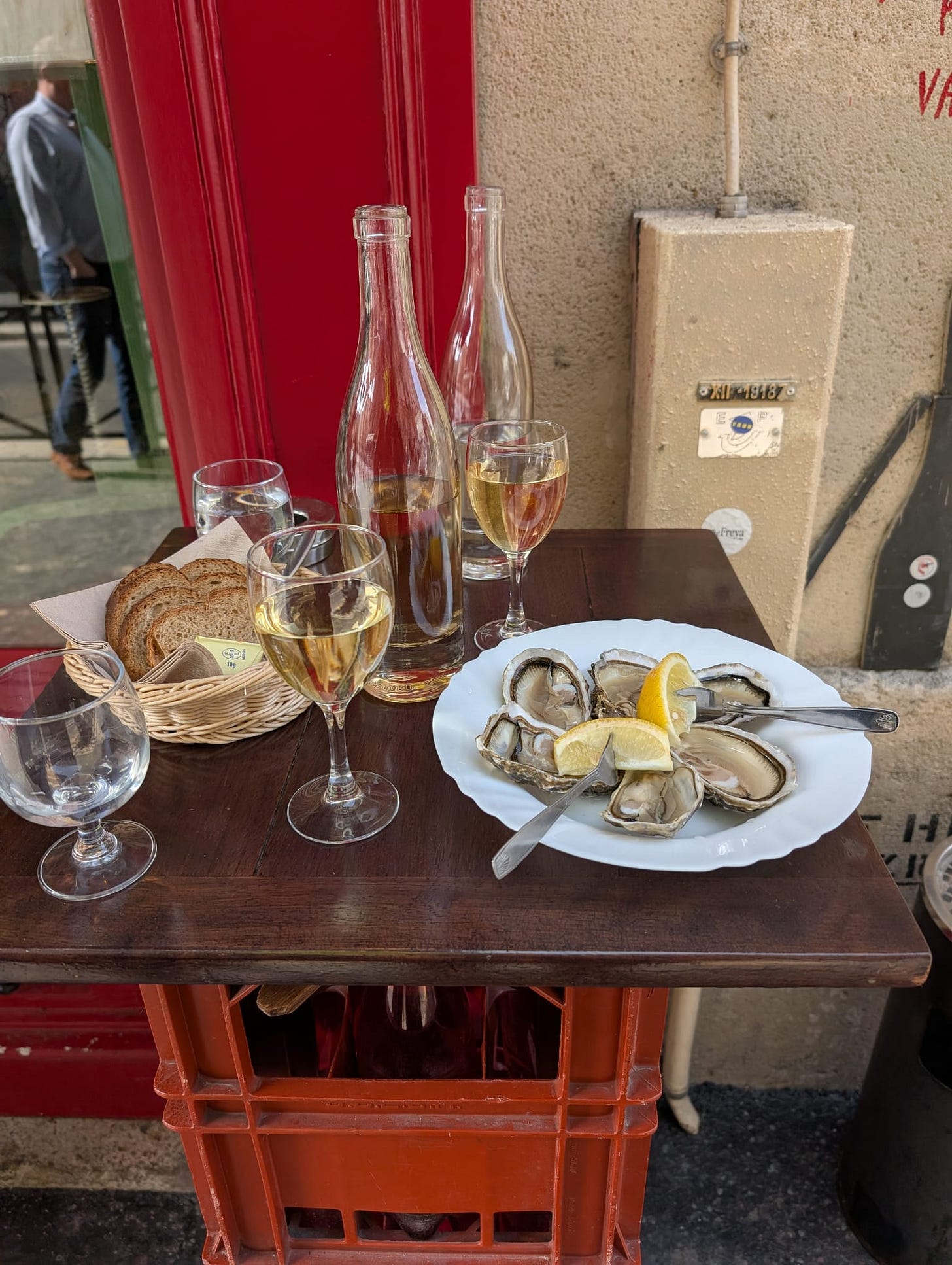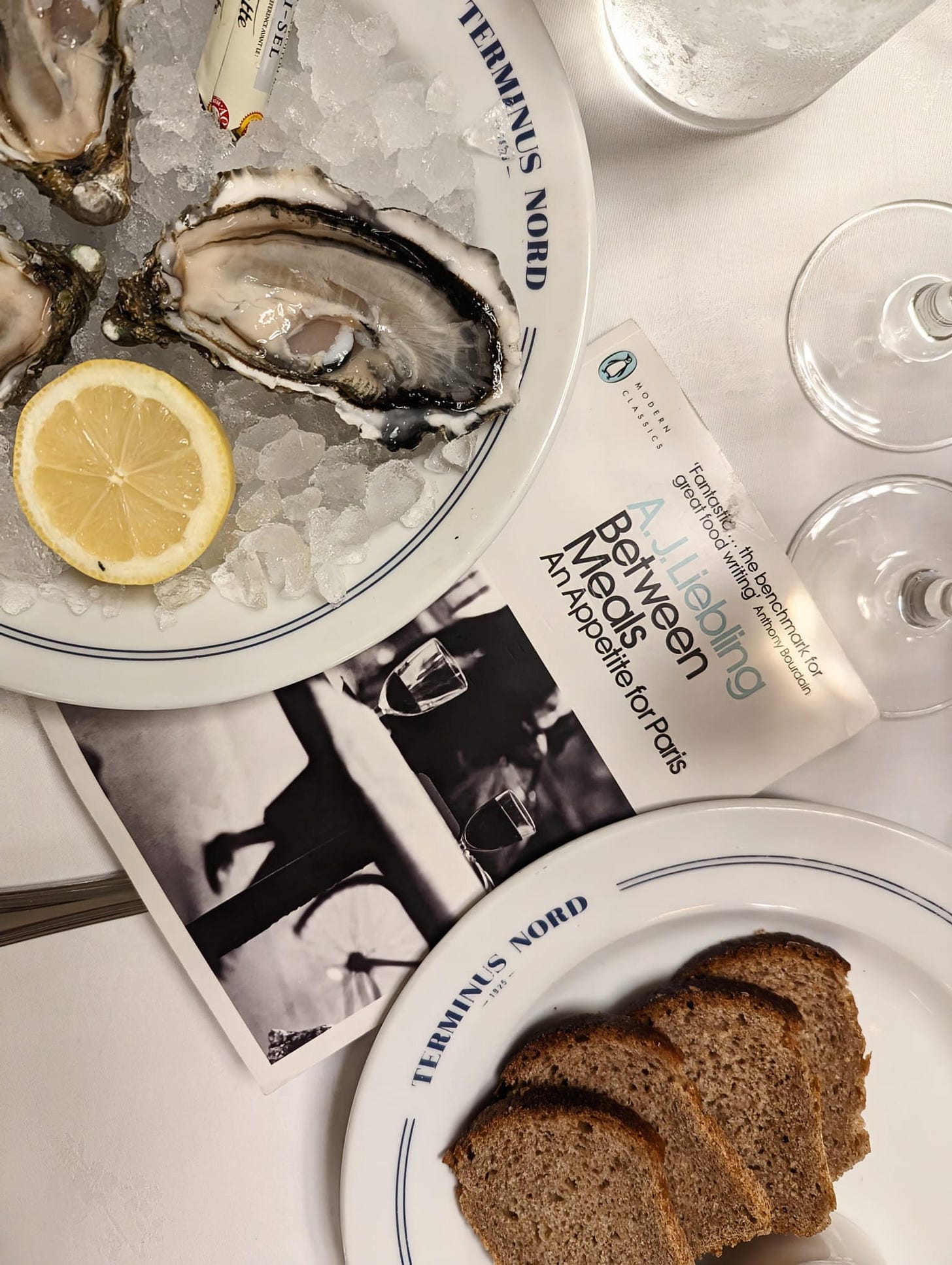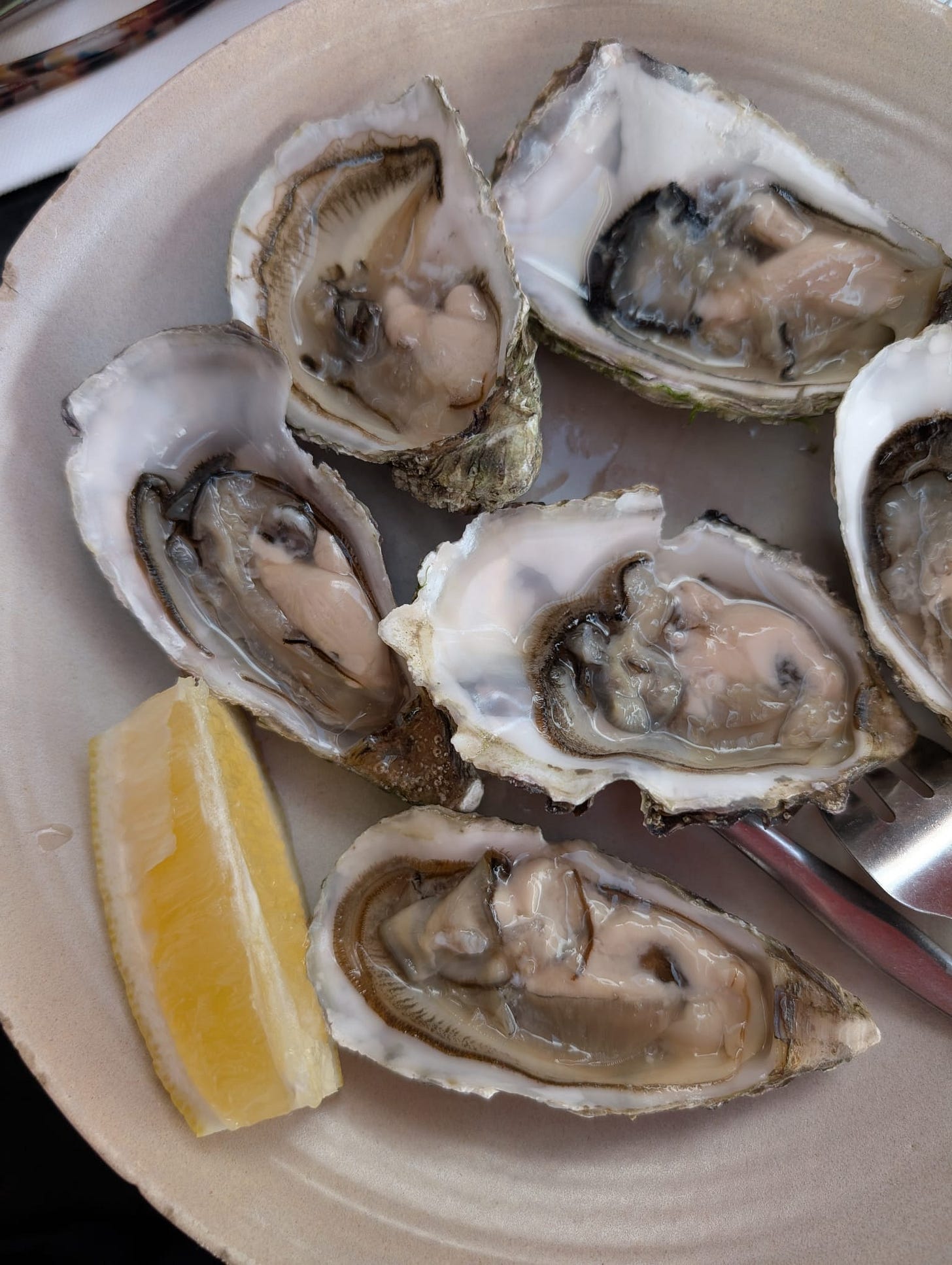The natural oysters of Paris
A bivalve journey around the French capital.
Consider the oyster: millions of years old, once a delicacy for the Greek and Roman elites, later a 19 Century working man’s staple and now, as the season has begun, a common bar snack in many Parisian brasseries. Though as I discovered on a recent trip to my local fishmonger, not all oysters are created equally. Some are thought of as more natural than others.
“These oysters are diploid…" explains the owner of Vent et Marée in the 19th arrondissement while gesturing at an array of different shells on crushed ice. “This means they can breed in the wild, so they are considered natural.” I nod along but these days the fishmonger knows my confused face too well. He reaches behind the counter and offers me a flyer from one of his distributors.
It turns out that a diploid natural oyster has one pair of 10 chromosomes while the infertile triploid oyster has an extra set of chromosomes and is created artificially by crossing a tetraploid male (four sets of chromosomes) with a diploid female. Fascinating as it is, none of this bivalve breeding information sounds particularly appetising, so I ask the obvious question: do natural oysters taste better?
“Personally, I think they do.” he replies. “Though they are becoming harder to find. Less than 5% of the oysters in France these days are natural.” I’m not sure if that statistic is correct, but I am intrigued about the potential difference in taste between two things that I didn't know existed 10 minutes ago. Then I start to question what it is that I actually like about oysters in the first place.
People say they have an aphrodisiac effect, but I find that knocking back a salty blast of the sea and chasing it with a glass of dry white wine is more transcendental than erotic. Just like doing LSD or yoga, the environment where you partake in your experience is integral to the nature of the trip. Could I even tell the difference between natural oysters and those that are artificially inseminated, or do I just enjoy sitting in the bars that sell them. I decided I owed it to the fishmonger to find out.
My first stop is Le Baron Rouge (1 Rue Théophile Roussel, 75011), a bustling, rustic wine bar just a few steps away from the Aligre market. On the weekends a couple set up an oyster station outside the bar and shuck directly for the people on the terrace. This environment is perfect oyster eating conditions: the air bristling with energy from the market, young bobo Parisians in their roll necks sitting next to anarchists with black cat badges sewn onto their denim jackets, everyone coming together for the love of briny flesh and affordable wine. Yet when I arrive on a crisp Saturday morning in early September the terrace is empty.
Inside, the barman is setting up and I ask him whether or not I will remain oysterless today. “The season is late,” he tells me, “we only sell natural oysters and they are still too milky.” He is referring to the soft roe that oysters produce during their reproductive season, which the Official Website of Tourism in Brittany assures “has no effect on the taste or nutritional value of the oyster”. Normally, though, the mating period is over by the end of August. This conversation is taking place mid September. The barman shrugs. “We’ll have them on the 21st.” (FYI - I wrote this last year so do check if they have started serving or not)
While disappointing, this turn of events does help my experiment. If natural oysters are not yet ready to be eaten then that must mean any I find are of the non-breeding triploid variety. Or perhaps some do indeed like them milky. I happen to know a few places that serve oysters all year round. However, since I’m already at Le Baron Rouge, I may as well have a quick glass at the bar. Behind the counter is a wall of 20 or so different wines, by the glass, carafe or bottle. Before the barman can serve me, though, the phone rings and he picks it up. “Hello?” he answers brightly. “No, not until the 21st.”
Next stop is the Avant Comptoir de La Mer (3 Carr de l'Odéon, 75006). It’s a wonderful little tapas spot, with photographs of dishes hanging from the roof and the long thin bar that Anthony Bourdain used to enjoy sitting at. I prefer to perch on a stool outside, directly in front of the oyster station, and watch the well-heeled human traffic strut through the Odeon quatier to pose on Rue de Seine. There are plenty of oysters on show here, so I bite my lip and ask the tattooed barman if they are natural.
“Of course they are natural!” He recoils as if I had insulted his mother. “Like everything here! All natural products.”
Embarrassed, I try to explain that I thought the season was late and the natural oysters were too ‘laiteuses’ at the moment, but apparently the memo about the 21st September hadn’t reached the 6eme arrondissement.
“So what do you want then?” the barman asks, his oyster glove at the ready. “Salty, not too salty?” I opt for three Marennes-Oléron and ask for a glass of Fleurie.
“I’ve no Fleurie left,” replies the barman, “but I’ve something you’ll like.” He goes off to the wine fridge beyond the plastic curtains and I’m left to examine the plate in front of me. The oysters are served, like pretty much everything in Avant Comptoir de La Mer, with some kind of pork, in this case, three little fried sausages. It’s a nod to the bar owners’ origins as a butcher and the only place I’ve ever been to they served bangers with bivalves. The oysters themselves do look a little, well, milky.
The barman returns with a fizzy natural chardonnay from Beajouloais and I cautiously pick up my first shell. 17th Century satirist Jonathan Swift once said that it was a bold man who ate the first oyster, and I know they didn’t have triploids 250 years ago. I knock the first one back and it’s just great. Tourism in Brittany were correct, you can’t taste this milkiness at all. All that’s left to do is enjoy the flavour, the Pet Nat wine and the view of rush hour Paris. The barman, who has also been engaging in some people-watching, points out a particularly attractive Parisien walking by.
“My god,” he says, shaking his head. “I should be blind.”
One place you will never fail to find an oyster is Terminus Nord (23 Rue de Dunkerque, 75010). A not exactly trendy brasserie directly in front of Gare Du Nord, the Terminus has been serving travellers with seafood platters since 1925 and the decor hasn’t changed much since then. The place has a wonderful art deco feel, all the charm of a gangster’s cigarette box. I love the mirrors, the orb lamps, white tablecloths and smart staff in traditional waistcoats. A chirpy waitress seats me at a small table by the bar, which means I can admire the spirit collection which has been aesthetically arranged as though it were in a department store window.
The oysters on the menu are mostly fine de claire but there is no extra information about their mating habits or lack thereof. When the waitress comes back I inquire whether these are natural oysters or not, but she doesn’t seem to know what I’m talking about. Diploid? Triploid? Nothing rings a bell and I start to feel like a real tool for asking. I quickly order three medium sized fine de claire for ten euros and a glass of chablis that costs about the same.
Just across from me, at the front of the restaurant, is a screen with upcoming Gare du Nord departure times. It’s a reminder that this is a train station restaurant, which is one of the reasons that the hip crowd don't come here and probably the main reason why I do. There’s a strange, excited energy about a place where everyone is just about to travel, and it provides an interesting backdrop for eating oysters, whether they are natural or not.
The fine de claires arrive and I taste one, carefully looking for any subtle differences. It’s sharp, salty and fresh, exactly what I was hoping for. I close my eyes to enjoy the moment while listening to the hum of people who soon will be miles away on a train somewhere. Possibly alarmed, the waitress comes over to check on me, and ends up chatting about what I’m scribbling in my notebook. She tells me my handwriting is pretty. She’s definitely getting a tip.
Attempting to go to Le marché des Enfants Rouges (39 Rue de Bretagne, 75003), on a Saturday afternoon is the definition of madness, but I’m high on sea air now and looking for more. A covered food market in the middle of the Marais, it’s been operating since 1628, but in recent years it’s done the rounds of social media internationally which has made it incredibly popular. This is surely great for the market’s many restaurants but the Saturday crowd is not one I particularly enjoy eating around.
As expected, it’s rammed with weekend gourmets and aspiring food influencers. The seafood counter is particularly full, and I know that even if I get a space I won’t enjoy sitting there while listening to people narrate what they are eating for a reel. It’s perhaps fitting, considering the journey of oysters themselves from poor man’s protein to posh nosh, that a street market named after an orphanage on what used to be a swamp would become a heaving hang out spot for the TikTok crowd. I decide to leave the social media merchants to it and come back during the week when it is less busy. For now I will head to the Jacques Bonsergent area to try something different.
The menu at Sur Mer (53 Rue de Lancry, 75010) states that their oysters are all natural, which saves me the embarrassment of having to ask. The place has an Asian fusion vibe, so I’m not surprised when the oysters arrive with a nam jim sauce instead of sliced lemon. At three for 10 euros they are big and juicy and probably have a powerful sea taste to them. I say probably because the spicy sauce all but overwhelms the natural flavours of the oyster and takes the experience in a completely new direction. It’s unconventional but quite delicious all the same. To accompany them I pick a natural Chardonnay from Alsace, and it is honestly the best glass of white wine I’ve tasted in a long time.
As pleasant as this exercise has been, I’m still no closer to discovering if natural oysters actually taste any different from their rivals. To end this once and for all, I head back to the fishmonger on Sunday morning and ask for three of his best diploids and three tripolid for comparison. The natural oysters are Speciale de la mer No.3 and the triploid control group are Gillardeau No.3, their shells proudly marked with the logo of the maison. Having two different types of oyster obviously complicates this experiment, but like all pioneers I’ll just have to work with what I have.
The Gillardeau are larger, meatier and full of juice, though they are not so salty and taste almost sweet. The natural oysters are noticeably smaller but pack much more sea flavours. At first I think the Speciale de la mer are the clear winner but after another Gillardeau I start to enjoy the meatiness and the subtlety of their taste. Then with another Speciale I’m back in the frothy swell and can practically feel the northern wind on my face. I finish the lot and can’t in good faith identify a winner. There’s only one thing to do in a situation like this. In the name of science, I must head back into Paris and try even more oysters. It's what Jonathan Swift would have wanted.







